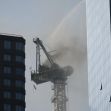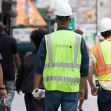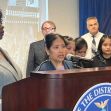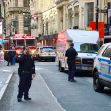The investigation into what caused the partial collapse of the seven-story Morris Heights apartment building in the Bronx Monday afternoon is still ongoing. Miraculously, the Fire Department Commissioner Laura Kavanagh announced during a news briefing that there were no deaths that resulted from the collapse. Only two individuals were reported to have suffered minor injuries.
In the late evening hours on the day of the collapse, the Fire Department shared online, "For hours, FDNY members searched for potential victims of the partial building collapse at 1915 Billingsley Terrace. They have gone through a large pile of debris, 12 feet high in spots, and found no victims. Two civilians sustained minor injuries during the evacuation."
The collapse is currently being investigated by the Department of Buildings personnel. The building, which dates back to 1927, falls under New York City's façade law. Under this law, every five years, the facades of NYC buildings six stories or higher must be inspected by a DOB official who is a Qualified Exterior Wall Inspector, known in the trade as a QEWI. A report must also be filed with the DOB.
According to reports, the building's owners submitted their most recent report in March 2021. The report identified seven unsafe facade conditions, but it does not appear any work was done to repair these issues.
A preliminary investigation into the collapse found that the general contractor working on the building, Arsh Landmark General Construction, Corp., was issued a summons last month by city inspectors. The inspector wrote on the summons, “I observed there are deteriorated and broken mudsills with inadequate support for vertical members throughout," including “1 vertical member with missing mudsill which can compromise the structural stability causing a potential collapse.”
The building’s owners had been told by Richard Koenigsberg, an engineer hired by the building’s owner, that the building’s exterior was “unsafe” in a 2020 report. His investigation found exterior issues including "cracked brick; vertical cracks at sills and water tables; loose and damaged mortar; a slightly bowed section of parapet; cracks at the parapet interior; the parapets are less than 42 inches in height at some locations."
Although the exterior’s condition was deemed to be “unsafe” Under New York City code, an "unsafe" facade does not mean the entire building is unsafe or structurally unstable. Still, building violations can serve as evidence that the owner or contractor was on notice of unsafe conditions and had a duty to fix them.
Leandros A. Vrionedes, a New York personal injury attorney who handles construction accident cases in New York City, points to the building’s history of code violations as a potential source of liability for the owners as well as the general contractor who was working on the building over the period during which the collapse occurred. As one example, he cites the Arsh Landmark summons issued by the City. “The contractor could face civil penalties, suspension or revocation of a City license or permit, and even a civil monetary judgment,” says Vrionedes.
“If any workers were seriously injured,” Vrionedes continues, “the contractor and/or the owner could be held liable under several different laws and legal theories, including general negligence under New York Labor Law section 200.” Vrionedes also says that building collapses are covered under New York’s Scaffold Law, which holds building owners and contractors liable for injuries caused by gravity-related incidents, including falls, falling objects, and scaffold or building collapses.
Vrionedes also says that in cases of severe injury or death to a worker, the recently enacted Carlos’ Law allows the City to issue a fine of up to $500,000.
While the investigation is still in its early stages, investigators are unable to determine if the sidewalk shed collapsed under the weight of the facade or if the scaffolding became unstable first and then pulled parts of the wall down with it. It is also not clear in the summons report whether the inspector was referring to a “potential collapse” or if the reference was about the scaffolding of the building.
According to reports, a contractor hired by the city was working on a below-ground water main. Ian Michaels, spokesperson for the city Department of Design & Construction (DDC), issued a statement that explained the vendor, EIC Associates, “was working across the street on the block of the collapse earlier in the day.” It’s not believed the water main work being done was related to the collapse; however, Koenigsberg says that the water main work cannot yet be ruled out as a potential cause. He shares that the first floor is where the failure appeared to have taken place. The New York Times has also reported on an employee of a tax preparation company located on the first floor of the building witnessing a major water leak moments before the collapse happened.
A spokesman for the Bronx District Attorney's Office has shared that the investigation will be conducted by the DOB and the FDNY. There are no plans at present to conduct a separate investigation into the owners of the building.






